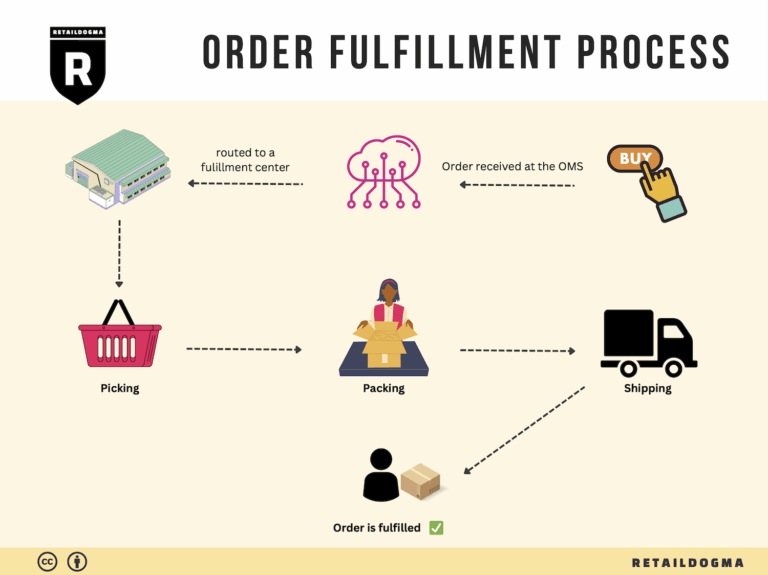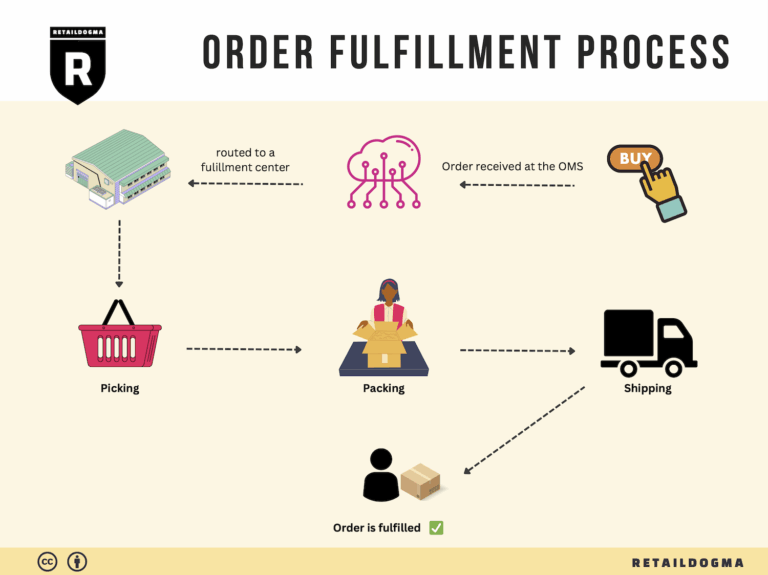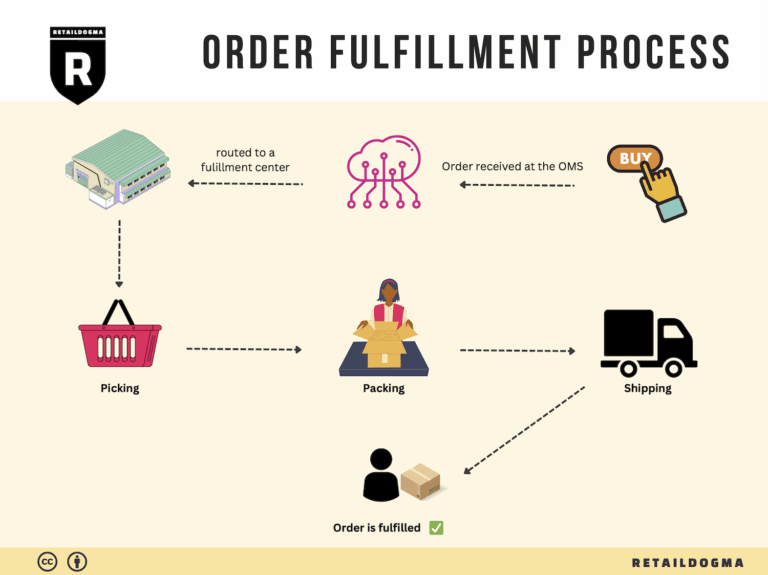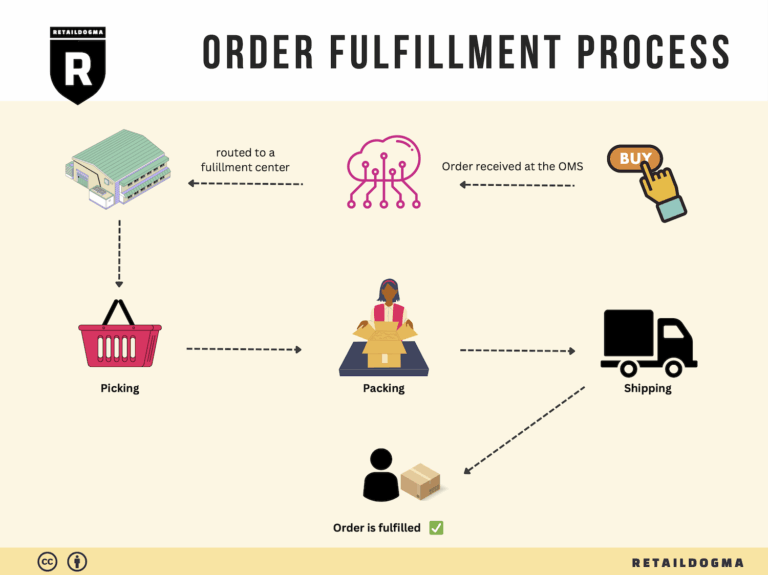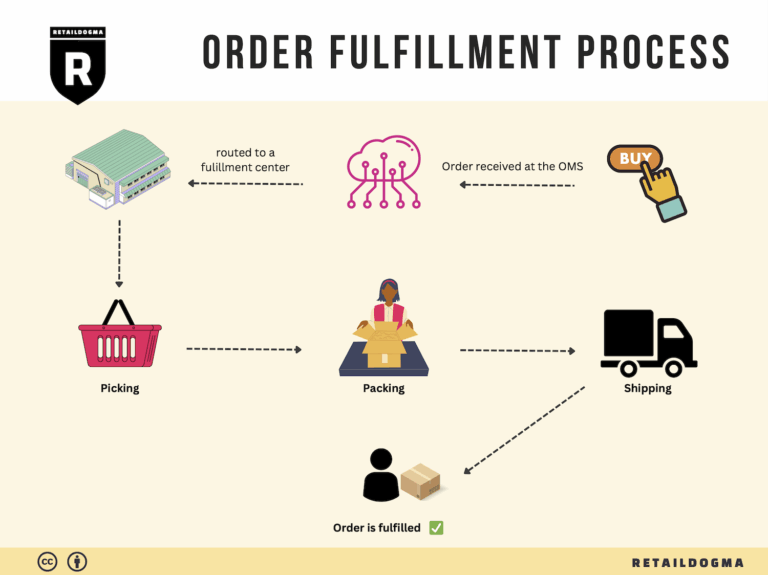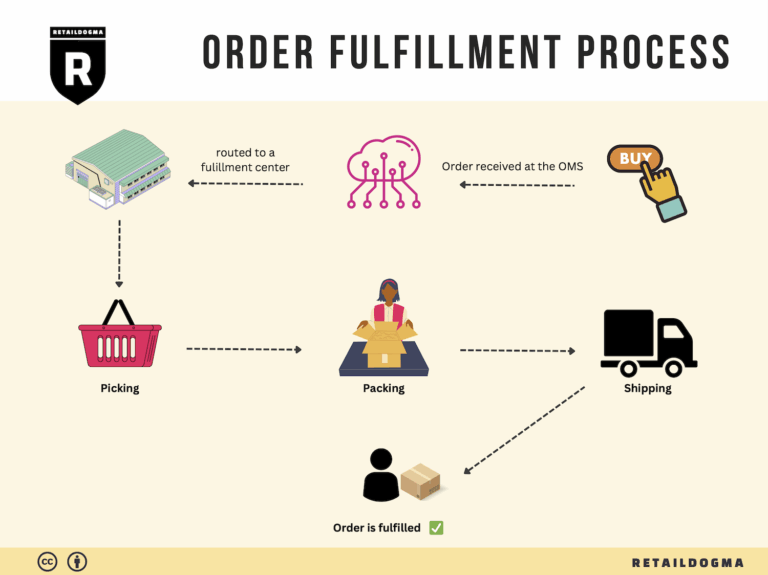What Is A Fulfillment Center? A Complete Guide (2025)
What is E-commerce Fulfillment? An Introduction for Growing Businesses
Understanding E-commerce Fulfillment: A Lifeline for Growing Businesses
As an e-commerce business owner, you might find yourself grappling with the challenges of packing and shipping orders, especially as your sales begin to scale. The sheer volume of orders can quickly become overwhelming, leading to potential delays, errors, and a decline in customer satisfaction. This is where effective e-commerce fulfillment comes into play. At its core, fulfillment is the process of getting a product to a customer, encompassing everything from inventory management to shipping logistics.
In today’s fast-paced online marketplace, having a robust fulfillment strategy is not just a luxury; it’s a necessity for sustainable growth. This guide aims to demystify the world of e-commerce fulfillment, providing you with the knowledge and tools to streamline your operations effectively.
What This Guide Covers
-
Fulfillment Models: We will explore various fulfillment models that can cater to your business needs, including Third-Party Logistics (3PL) and Fulfillment by Amazon (FBA). Each model has its unique advantages and challenges, and understanding these can help you select the right approach for your business.
-
Core Services: We will delve into the essential services that fulfillment partners typically offer, such as warehousing, order processing, packing, shipping, and customer notifications. Knowing what services are available can help you identify what you need to scale efficiently.
-
Choosing a Partner: Selecting the right fulfillment partner is critical to your success. This section will provide practical tips on evaluating potential partners based on their capabilities, technology, and customer service.
-
Pricing Structures: Understanding how fulfillment pricing works is crucial for budgeting and financial planning. We will outline common pricing models and factors that influence costs, enabling you to make informed decisions.
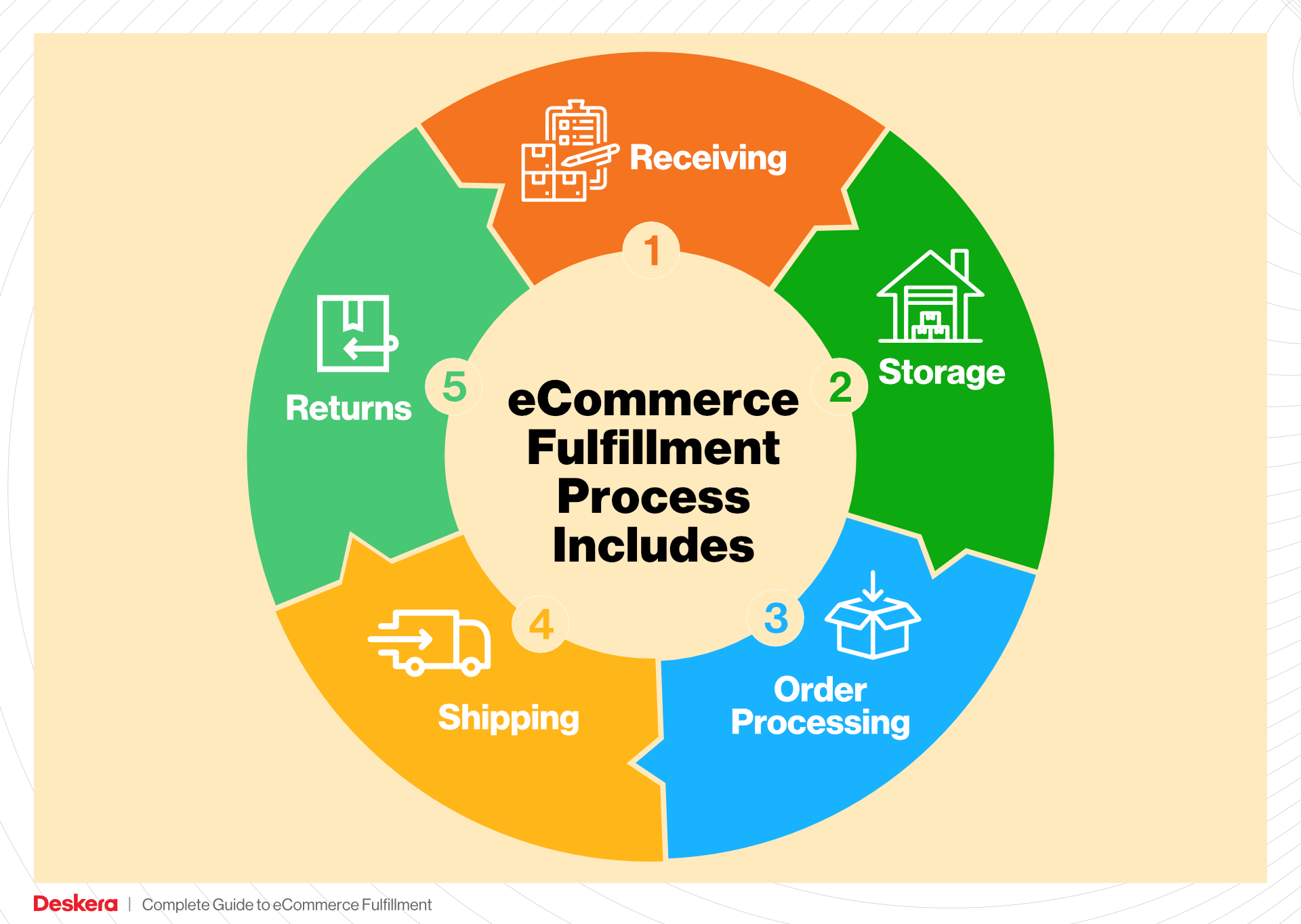
Empowering Your Business
Our goal with this guide is to empower you to make smart decisions about your logistics. By equipping you with insights into e-commerce fulfillment, we aim to alleviate the stress associated with shipping and order management, allowing you to focus on what you do best: growing your business. Whether you’re just starting or looking to optimize your existing operations, this guide will serve as a valuable resource in your e-commerce journey.
What You’ll Learn In This Guide
- What is E-commerce Fulfillment? An Introduction for Growing Businesses
- The Order Fulfillment Process: From ‘Buy’ Button to Customer’s Door
- Comparing Fulfillment Models: In-House vs. 3PL vs. Dropshipping
- A Deep Dive into Amazon FBA: Pros, Cons, and Who It’s For
- Core Services Offered by Fulfillment Centers
- How to Choose a Fulfillment Partner: A 6-Point Checklist
- Understanding Fulfillment Pricing: A Breakdown of Common Fees
- Frequently Asked Questions (FAQs) about Fulfillment
- Conclusion: Is Outsourcing Fulfillment the Right Move for Your Business?
- Important Disclaimer
The Order Fulfillment Process: From ‘Buy’ Button to Customer’s Door
1. Receiving Inventory
The first step in the order fulfillment process is receiving inventory at your fulfillment center. This involves checking in products from suppliers, verifying that the quantity and quality match the purchase orders, and logging items into your inventory management system.
Importance: This step is crucial because it sets the foundation for all subsequent fulfillment activities. Accurate receiving ensures that you have the correct products on hand, which minimizes errors later in the process. If there are discrepancies, they can be addressed immediately, preventing potential stockouts or overstock situations.
Key Term: SKU (Stock Keeping Unit) – This unique identifier is essential for tracking inventory levels and managing stock efficiently. By assigning SKUs to each product, you can streamline the receiving process and improve overall inventory accuracy.
2. Warehouse Storage
Once the inventory is received and logged, the next step is warehouse storage. Products are organized and stored in designated locations within the fulfillment center, often based on factors like size, weight, and demand.
Importance: Effective storage strategies can significantly enhance operational efficiency. By optimizing the layout of your warehouse, you reduce the time it takes to locate and retrieve products when orders are placed. This directly impacts your ability to fulfill orders quickly and accurately, which is vital for customer satisfaction.
Key Term: FIFO (First In, First Out) – This inventory management principle ensures that older stock is sold before newer stock, helping to minimize waste and obsolescence, particularly for perishable items.
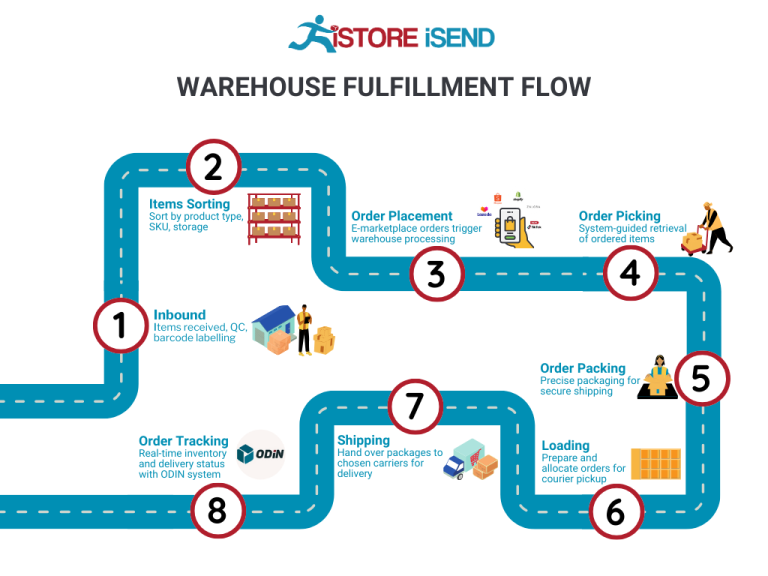
3. Order Picking
When a customer places an order, the next step is order picking, where warehouse staff retrieve the items from their storage locations based on the order details. This process is guided by a pick list, which outlines the items and quantities needed for each order.
Importance: Order picking is a critical step that directly influences fulfillment speed and accuracy. Efficient picking processes help ensure that customers receive the correct items in a timely manner. Errors in this stage can lead to increased returns and dissatisfied customers.
Key Term: Pick Lists – These documents detail the specific items and quantities to be retrieved for each order. Utilizing pick lists can streamline the picking process and ensure that order fulfillment is both efficient and accurate.
4. Order Packing
After the items have been picked, they move to the order packing stage. Here, products are carefully packed into shipping boxes, often with branded materials and protective packaging to ensure they arrive in perfect condition.
Importance: The packing process is essential for protecting products during transit and enhancing the customer experience. A well-packed order not only prevents damage but can also delight customers with thoughtful touches, such as personalized messages or promotional materials, reinforcing your brand identity.
Key Term: Branded Packaging – This involves using custom boxes, tape, and inserts that feature your logo and brand colors. Branded packaging elevates the unboxing experience and can serve as a marketing tool, making your product memorable.
5. Shipping & Delivery
The final step in the fulfillment process is shipping and delivery. Once orders are packed, they are labeled and handed over to shipping carriers for delivery to customers. This stage involves tracking shipments and notifying customers about their order status.

Importance: Shipping speed and reliability are paramount in e-commerce. Customers expect prompt delivery, and delays can lead to dissatisfaction and lost business. Providing accurate tracking information also enhances the customer experience by keeping them informed about their order’s progress.
Key Term: Delivery Tracking – This allows customers to monitor their shipment in real-time, providing transparency and building trust in your brand. An effective tracking system can reduce customer inquiries and enhance satisfaction.
By understanding and optimizing each step of the order fulfillment process, e-commerce businesses can scale efficiently, enhance customer satisfaction, and improve overall operational effectiveness. Implementing best practices in these areas not only streamlines operations but also aligns fulfillment with marketing strategies, creating a cohesive approach to customer engagement.
Comparing Fulfillment Models: In-House vs. 3PL vs. Dropshipping
Fulfillment Model Comparison Table
| Model | Who Handles Inventory | Best For (Business Stage) | Key Advantage | Key Disadvantage |
|---|---|---|---|---|
| In-House Fulfillment | The business itself | Startups to established | Full control over inventory and processes | High overhead costs and resource-intensive |
| Third-Party Logistics (3PL) | A third-party provider | Growth and scaling | Scalability and reduced operational burden | Less control over fulfillment processes |
| Dropshipping | Supplier or manufacturer | New entrepreneurs and small businesses | Low upfront investment and risk | Lower profit margins and longer shipping times |
In-House Fulfillment
In-house fulfillment refers to the model where the e-commerce business manages its own inventory, warehousing, packing, and shipping processes. This approach allows for complete control over every aspect of the fulfillment process, enabling businesses to tailor their operations to their specific needs and customer expectations. Companies that opt for in-house fulfillment often invest in warehouse space, hire staff, and implement inventory management systems. This model is particularly beneficial for established businesses that have a steady volume of orders and can justify the overhead costs associated with running a fulfillment center. However, it can be resource-intensive, requiring significant time, labor, and financial investment, which can strain the operations of startups or smaller businesses.
Third-Party Logistics (3PL)
Third-party logistics (3PL) providers offer businesses the opportunity to outsource their fulfillment needs to specialized companies. These providers manage warehousing, inventory control, order processing, packing, and shipping on behalf of their clients. Utilizing a 3PL is particularly advantageous for e-commerce businesses looking to scale quickly without incurring the high costs and complexities associated with in-house fulfillment. A key advantage of this model is the flexibility it offers; businesses can easily adjust their fulfillment needs as they grow, accessing additional resources and services such as kitting, returns management, and advanced tracking systems. However, businesses must be mindful that outsourcing fulfillment means relinquishing some control over the customer experience, which can impact brand perception if the 3PL does not meet expectations.
Dropshipping
Dropshipping is a fulfillment model where the retailer does not keep products in stock but instead partners with suppliers or manufacturers who fulfill orders directly to the customer. This model is particularly appealing to new entrepreneurs and small businesses, as it requires minimal upfront investment and eliminates the need for inventory management and warehousing costs. Retailers can focus on marketing and customer service rather than logistical challenges, allowing for a leaner operation. However, dropshipping also presents challenges, including lower profit margins due to reliance on suppliers, potential issues with inventory availability, and longer shipping times that can affect customer satisfaction. Additionally, because the retailer has little control over the fulfillment process, maintaining a consistent brand experience can be challenging.
Conclusion
When choosing a fulfillment model, e-commerce business owners must consider their current operational capabilities, growth ambitions, and customer expectations. In-house fulfillment provides total control but at a higher cost, making it suitable for established companies. 3PL offers scalability and reduced burden, ideal for businesses in growth phases, while dropshipping allows newcomers to enter the market with minimal investment but comes with its own set of challenges. By carefully evaluating these models, businesses can align their fulfillment strategy with their overall objectives, ensuring efficiency and customer satisfaction.
A Deep Dive into Amazon FBA: Pros, Cons, and Who It’s For
Understanding Fulfillment by Amazon (FBA)
Fulfillment by Amazon (FBA) is a service offered by Amazon that allows sellers to store their products in Amazon’s fulfillment centers. Amazon then takes care of storage, packaging, shipping, and customer service for these products. This service is particularly beneficial for e-commerce businesses looking to leverage Amazon’s extensive logistics network and customer base.
How FBA Works
-
Product Listing: Sellers create listings for their products on Amazon’s marketplace. They can choose to use FBA for some or all of their items.
-
Inventory Shipment: Sellers ship their products to Amazon’s fulfillment centers. Amazon provides guidance on how to package and label these items to ensure they are processed efficiently.
-
Storage: Once the products arrive at the fulfillment center, Amazon stores them until they are sold. Sellers can monitor their inventory levels through their Amazon Seller Central account.
-
Order Processing: When a customer places an order, Amazon handles the entire fulfillment process. This includes picking the product from the shelf, packing it, and shipping it directly to the customer.
-
Customer Service: Amazon also manages customer inquiries, returns, and refunds for FBA orders, providing a seamless experience for buyers.
-
Reporting and Analytics: Sellers have access to detailed reports on their sales, inventory status, and customer feedback, helping them make informed decisions.
Pros of Using FBA
1. Prime Eligibility
One of the standout advantages of FBA is the ability to offer products with Amazon Prime eligibility. This is crucial as Prime members tend to spend more and expect fast, reliable shipping. Being part of the Prime program can significantly increase sales opportunities for sellers.
2. Customer Trust
Amazon is a trusted name in e-commerce. By using FBA, sellers can benefit from Amazon’s reputation, which can enhance their credibility. Customers are more likely to purchase from sellers who provide Amazon’s reliable shipping and customer service.
3. Multi-Channel Fulfillment
FBA is not limited to just Amazon sales. Sellers can also use FBA for orders from their own websites or other sales channels. This multi-channel fulfillment allows businesses to streamline their logistics while benefiting from Amazon’s infrastructure.
4. Scalability
FBA allows sellers to scale their business without having to invest heavily in their own warehousing and logistics. As sales increase, sellers can easily send more inventory to Amazon’s fulfillment centers without worrying about storage space.
5. Advanced Logistics
Amazon’s sophisticated logistics network ensures efficient order processing and shipping. With FBA, sellers can rely on Amazon to manage the complexities of logistics, allowing them to focus on other aspects of their business.
Cons of Using FBA
1. High Fees
While FBA can offer many benefits, it comes with a cost. Sellers must pay various fees, including storage fees and fulfillment fees, which can eat into profit margins, especially for lower-priced items or those with slow turnover.
2. Strict Inventory Rules
Sellers must adhere to Amazon’s strict inventory management policies. This includes limitations on how much inventory can be stored, which can be challenging for businesses that experience seasonal fluctuations or unexpected spikes in demand.
3. Commingling Risks
FBA involves commingling inventory, which means that products from different sellers may be stored together. This can pose risks, such as receiving damaged or incorrect items. Sellers have less control over their inventory, and problems can arise when items are returned or if there are quality issues.
4. Loss of Control
Using FBA means that sellers relinquish some control over their fulfillment process. Any issues with Amazon’s logistics, such as shipping delays or stockouts, can directly affect a seller’s reputation and customer satisfaction.
5. Complex Returns Process
While Amazon handles returns, the process can be complex for sellers. They may face challenges with tracking returns and managing inventory that has been returned, which can complicate inventory management.
Who is FBA Best For?
Fulfillment by Amazon is particularly well-suited for:
-
Small to Medium-Sized E-commerce Businesses: Businesses that want to leverage Amazon’s massive infrastructure without investing heavily in their own logistics can benefit significantly from FBA.
-
Sellers with Established Products: Brands with established products that have consistent sales can maximize the advantages of FBA, especially in terms of Prime eligibility and customer trust.
-
Businesses Looking to Scale: Companies aiming for rapid growth can utilize FBA to handle increased demand without the hassle of managing fulfillment logistics.
-
Sellers Focused on Customer Service: Those who want to provide excellent customer service without managing the intricacies of returns, refunds, and shipping will find FBA beneficial.
-
Multi-Channel Sellers: Businesses that sell on multiple platforms can streamline their operations by using FBA for all their fulfillment needs, allowing them to maintain a consistent service level across channels.
In conclusion, while Fulfillment by Amazon offers a range of benefits, it is essential for businesses to carefully evaluate the costs and operational implications. Understanding both the advantages and the challenges will enable e-commerce owners and operations managers to make informed decisions about whether FBA aligns with their business goals.
Core Services Offered by Fulfillment Centers
Inventory Management & Warehousing
Inventory management and warehousing are foundational services provided by fulfillment centers that directly impact an e-commerce business’s operational efficiency. This service involves storing products in a dedicated warehouse facility and managing stock levels to ensure that the right amount of inventory is available at all times.
What It Is: Fulfillment centers utilize sophisticated inventory management systems that track stock levels, monitor sales trends, and automate reordering processes. This ensures that businesses can maintain optimal inventory levels without overstocking or running out of popular items.
Benefits:
1. Cost Efficiency: By utilizing a fulfillment center’s warehousing capabilities, e-commerce businesses can reduce overhead costs associated with maintaining their own storage facilities. This is especially valuable for small to mid-sized businesses that may not have the capital for extensive warehousing.
-
Scalability: As your business grows, fulfillment centers can easily adjust the amount of space and resources allocated to your inventory. This flexibility allows for quick scaling without the logistical headaches of moving to a larger warehouse or managing excess inventory.
-
Enhanced Visibility: Modern inventory management systems provide real-time data on stock levels and sales trends, allowing businesses to make informed decisions. This visibility can lead to better forecasting and reduced instances of stockouts or excess inventory.
Pick and Pack Services
Pick and pack services are critical components of the order fulfillment process. This service involves selecting items from the warehouse based on customer orders, packing them securely, and preparing them for shipment.
What It Is: When an order is placed, fulfillment staff “pick” the items from the shelves and “pack” them into boxes or shipping containers for delivery. This process can be customized to meet specific requirements, such as including promotional materials or branded packaging.
Benefits:
1. Accuracy and Speed: Fulfillment centers employ trained staff and technology to ensure that orders are picked and packed accurately. This reduces the likelihood of errors, which can lead to costly returns and customer dissatisfaction.
-
Improved Customer Experience: Efficient pick and pack services contribute to faster order processing and shipping times, which are crucial for customer satisfaction. In today’s e-commerce landscape, consumers expect quick delivery, and fulfillment centers can help meet these expectations.
-
Customization Options: Many fulfillment centers offer customizable packing solutions, such as branded packaging or special inserts. These options enhance the unboxing experience and can reinforce brand identity, ultimately leading to increased customer loyalty.
Kitting and Assembly
Kitting and assembly services involve the process of grouping individual items together into a single package or kit. This can include assembling products that require multiple components or creating promotional bundles that combine various items.
What It Is: Kitting may involve tasks such as assembling a product from multiple parts, creating gift sets, or packaging samples for marketing purposes. This service helps streamline the order fulfillment process by preparing products in advance for quick dispatch.
Benefits:
1. Streamlined Operations: By having kitting and assembly services in-house, fulfillment centers can reduce the time it takes to prepare orders. This leads to faster shipping times and improved operational efficiency.
-
Enhanced Marketing Opportunities: Kitting allows businesses to create unique product offerings, such as bundled items or promotional kits. This can attract customers looking for value and can be an effective way to increase average order value.
-
Reduced Labor Costs: Outsourcing kitting and assembly tasks to a fulfillment center can save businesses from the labor-intensive process of preparing products themselves. This allows in-house staff to focus on other critical areas of the business, such as marketing and customer service.
Returns Management (Reverse Logistics)
Returns management, also known as reverse logistics, is an essential service offered by fulfillment centers that deals with the process of handling returned items. This service includes the return of products from customers back to the fulfillment center, assessing their condition, and processing refunds or exchanges.
What It Is: Effective returns management involves a streamlined process for customers to return items, inspecting returned products, and managing inventory adjustments. Fulfillment centers often provide a dedicated system for tracking returns and facilitating customer communication.
Benefits:
1. Customer Retention: A smooth returns process is crucial for maintaining customer satisfaction. Fulfillment centers can help businesses create a hassle-free return experience, which can encourage customers to shop again despite previous issues.
-
Inventory Control: By efficiently managing returns, fulfillment centers can quickly restock returned items or determine if they should be refurbished or discarded. This helps maintain accurate inventory levels and reduces losses from unsellable goods.
-
Data Insights: Returns management provides valuable insights into customer preferences and product performance. Analyzing return data can help businesses identify trends, such as common reasons for returns, enabling them to make informed decisions about product offerings and quality improvements.
In summary, the core services offered by fulfillment centers — inventory management and warehousing, pick and pack services, kitting and assembly, and returns management — are vital for e-commerce businesses aiming to enhance operational efficiency, improve customer satisfaction, and ultimately scale their operations. Leveraging these services can position businesses for sustained growth in a competitive e-commerce landscape.
How to Choose a Fulfillment Partner: A 6-Point Checklist
Location & Warehouse Network
The location of your fulfillment partner’s warehouses can significantly impact shipping times and costs. A strategically positioned fulfillment center can reduce transit times and improve customer satisfaction.
Why It Matters:
– Shipping Costs: Proximity to your customer base can lower shipping costs.
– Delivery Speed: Reducing the distance to your customers can lead to faster delivery times, which is crucial in today’s e-commerce environment.
Questions to Ask:
– Where are your warehouses located?
– How does your location strategy align with my customer demographics?
– Do you offer regional fulfillment options to optimize shipping times?
Technology & Integrations
In the age of e-commerce, having a robust technological backbone is essential. Your fulfillment partner should be equipped with advanced technology that integrates seamlessly with your existing systems.
Why It Matters:
– Real-time Tracking: Customers expect transparency regarding their orders, which requires effective tracking systems.
– Inventory Management: Advanced software can help manage inventory levels, automate reordering, and reduce stockouts.
Questions to Ask:
– What technology do you use for order management and tracking?
– Can your systems integrate with my e-commerce platform (e.g., Shopify, WooCommerce)?
– How do you handle data security and compliance?
Specializations (e.g., Cold Storage, Oversized Items)
Depending on your product line, you may need a fulfillment partner that specializes in certain types of products, such as perishable goods or oversized items.
Why It Matters:
– Product Safety: For items like food or pharmaceuticals, specialized storage and handling are necessary to ensure compliance with regulations.
– Handling Requirements: Oversized or fragile items may require specific packing and shipping methods.
Questions to Ask:
– Do you have experience handling my specific type of product?
– What special equipment or processes do you have in place for handling specialized products?
– Can you provide case studies or references from similar businesses?
Scalability & Capacity
As your business grows, your fulfillment partner must be able to scale operations to meet increasing demand without sacrificing service quality.
Why It Matters:
– Flexibility: A scalable partner can accommodate seasonal spikes or rapid growth phases.
– Long-term Partnership: Choosing a partner that can grow with you reduces the need for frequent changes, which can be disruptive.
Questions to Ask:
– How do you manage capacity during peak seasons?
– What strategies do you employ to ensure scalability?
– Can you provide examples of how you have supported other clients’ growth?
Pricing and Contracts
Understanding the pricing structure and the terms of the contract is crucial for maintaining profitability and avoiding unexpected costs.
Why It Matters:
– Budget Management: Clear pricing allows for better financial planning and budget adherence.
– Cost Transparency: Knowing all potential fees (e.g., storage, handling, shipping) upfront helps avoid surprises later.
Questions to Ask:
– What is your pricing model (e.g., per order, per item, monthly fees)?
– Are there additional costs I should be aware of (e.g., returns processing, seasonal surcharges)?
– What are the terms of the contract, including cancellation policies?
Customer Support & Reviews
Strong customer support is essential for resolving issues quickly and maintaining a smooth operation. Additionally, reviews from other businesses can provide insight into the partner’s reliability and service quality.
Why It Matters:
– Issue Resolution: Efficient customer support can significantly reduce downtime in your operations.
– Reputation Insight: Customer reviews can reveal strengths and weaknesses that may not be apparent during initial discussions.
Questions to Ask:
– What customer support options do you provide (e.g., phone, email, live chat)?
– How do you handle issues or disputes that arise during the fulfillment process?
– Can you provide references or testimonials from current clients?
Conclusion
Choosing the right fulfillment partner is a critical decision that can impact your e-commerce business’s efficiency, customer satisfaction, and ultimately, your bottom line. By using this checklist, e-commerce business owners, operations managers, and entrepreneurs can make informed decisions when evaluating potential 3PL partners. Consider each point carefully, ask the right questions, and look for a partner that aligns with your business goals and values.
Understanding Fulfillment Pricing: A Breakdown of Common Fees
Initial Setup Fees
Initial setup fees are typically one-time charges incurred when you begin working with a fulfillment provider. These fees can vary widely based on the complexity of your operations and the services required. Common components of initial setup fees include:
- Account Setup: This is the cost associated with creating and configuring your account in the fulfillment provider’s system. It may involve integrating your e-commerce platform with their software.
- Product Onboarding: This fee covers the process of entering your product information into the system, including SKUs, descriptions, and pricing. If you have a large catalog, this could be a significant cost.
- Training: Some providers may charge for training sessions to help you understand their systems and processes.
To get an accurate estimate of initial setup fees, discuss your specific needs with the fulfillment provider and request a detailed breakdown of what the fees cover.
Receiving Fees
Receiving fees are charged when your inventory arrives at the fulfillment center. These fees cover the costs associated with unloading, inspecting, and storing your products. Key aspects include:
- Unloading: This involves labor costs for unloading the shipment from trucks or containers.
- Inspection: Fulfillment centers often inspect incoming goods for quality and accuracy, ensuring that what was ordered matches what was received.
- Sorting and Storing: Once received, products are sorted and placed into their designated storage locations, which may incur additional labor costs.
Receiving fees can be calculated per pallet, box, or item, depending on the fulfillment provider’s pricing structure. To minimize these costs, ensure that your shipments are well-organized and labeled correctly before they arrive at the facility.
Storage Fees (per pallet/bin)
Storage fees are ongoing costs incurred for keeping your inventory at the fulfillment center. These fees can be calculated based on:
- Space Used: Providers typically charge based on the amount of space your products occupy, often measured in pallets or bins. For instance, if your products take up 10 pallets, you will be charged for 10 pallets of storage.
- Duration: Some fulfillment centers may also charge based on how long your inventory is stored. Long-term storage fees might apply if products remain in storage for an extended period, often exceeding 30, 60, or 90 days.
Understanding the storage fees can help you manage your inventory effectively. For businesses with seasonal products, consider negotiating a flexible storage plan that accommodates fluctuations in inventory levels.
Pick & Pack Fees (per item/order)
Pick and pack fees are charged for the labor involved in retrieving items from storage and preparing them for shipment. This fee structure can vary based on:
- Number of Items: Providers often charge a fee for each item picked from inventory. For example, if an order contains three items, you may incur three pick fees.
- Complexity of Orders: If your orders require special handling (e.g., kitting, bundling, or customized packaging), additional charges may apply.
To optimize pick and pack fees, streamline your product offerings and consider bundling items to reduce the number of pick operations needed per order. This can significantly lower costs and improve fulfillment efficiency.
Shipping Fees
Shipping fees are among the most variable and significant costs in fulfillment pricing. They are calculated based on several factors:
- Destination: Shipping costs can differ dramatically depending on whether the package is sent locally, nationally, or internationally.
- Weight and Dimensions: Carriers use dimensional weight pricing, meaning that both the actual weight and the size of the package affect shipping costs. Heavier or larger packages will incur higher fees.
- Shipping Speed: Expedited shipping options (e.g., overnight or two-day delivery) typically come at a premium compared to standard shipping rates.
To effectively manage shipping costs, negotiate rates with carriers, consider using flat-rate shipping options, and optimize your packaging to minimize dimensional weight.
Tips for Getting an Accurate Quote
-
Be Transparent About Your Needs: Clearly communicate your business model, product types, and expected order volumes to the fulfillment provider. This will help them provide a tailored quote that reflects your specific requirements.
-
Request a Detailed Breakdown: Ask for a line-item breakdown of all fees involved, including setup, receiving, storage, pick and pack, and shipping. This transparency will help you understand how costs are calculated.
-
Consider Seasonal Fluctuations: If your business experiences seasonal spikes in demand, discuss how these fluctuations will impact pricing and storage fees.
-
Evaluate Additional Services: Consider any value-added services you may need, such as kitting or custom packaging, and ensure these are included in your quote.
-
Negotiate Terms: Don’t hesitate to negotiate terms, especially if you have significant volume or a long-term partnership in mind. Many providers are willing to offer discounts or flexible pricing based on your commitment.
By understanding these common fulfillment pricing models and following these tips, you can better navigate the complexities of fulfillment costs and make informed decisions that align with your business goals.
Frequently Asked Questions (FAQs) about Fulfillment
1. What is marketing fulfillment?
Marketing fulfillment is the integration of fulfillment services into your marketing strategy. It involves using order fulfillment processes to enhance customer engagement, brand awareness, and loyalty. This can include sending promotional materials, branded packaging, or product samples alongside customer orders to create a memorable unboxing experience that supports your marketing goals.
2. How do fulfillment services support marketing efforts?
Fulfillment services can significantly enhance marketing by providing opportunities for customer interaction. This includes using branded packaging to reinforce brand identity, including promotional inserts with orders to encourage repeat purchases, and ensuring a delightful unboxing experience that fosters customer satisfaction and loyalty.
3. What is the difference between a warehouse and a fulfillment center?
A warehouse is primarily a storage facility for products, whereas a fulfillment center is designed to handle the entire order fulfillment process. Fulfillment centers not only store inventory but also manage picking, packing, shipping, and customer communication, making them essential for e-commerce businesses looking to streamline their operations.
4. What is a 3PL (Third-Party Logistics Provider)?
A 3PL is a company that provides outsourced logistics services, including warehousing, fulfillment, and shipping. E-commerce businesses often partner with 3PLs to leverage their expertise and resources, allowing them to focus on core business activities while ensuring efficient order processing and delivery.
5. How much do fulfillment services cost?
The cost of fulfillment services varies widely based on factors such as order volume, types of products, and specific services required (e.g., kitting, packaging, shipping). Generally, fulfillment costs can include storage fees, picking and packing fees, shipping costs, and any additional services. It’s crucial to obtain detailed quotes from potential fulfillment partners to understand the total cost structure.
6. What are the benefits of using branded packaging in fulfillment?
Branded packaging enhances customer experience by reinforcing brand identity and creating a memorable impression. It can differentiate your products in a crowded marketplace, encourage social sharing, and promote brand loyalty. Additionally, using eco-friendly packaging can positively impact customer perception and align with sustainability values.
7. How can I improve my unboxing experience?
To enhance the unboxing experience, consider using high-quality, branded packaging, adding personalized thank-you notes, and including promotional materials that offer discounts or encourage social media sharing. Thoughtful touches, like colorful tissue paper or sample products, can also delight customers and encourage repeat purchases.
8. What role does customer satisfaction play in fulfillment marketing?
Customer satisfaction is central to fulfillment marketing. Efficient and accurate order fulfillment builds trust and loyalty, leading to repeat purchases and positive word-of-mouth. Ensuring that orders are packed well, delivered on time, and include thoughtful elements can significantly enhance the customer experience, making it a powerful marketing tool.
9. How can I align my marketing and fulfillment strategies?
To align your marketing and fulfillment strategies, facilitate regular communication between your marketing and logistics teams. Identify synergies, such as incorporating promotional inserts into packages or leveraging customer feedback to improve service. Additionally, consider budgeting for fulfillment costs within your marketing strategy to enhance customer engagement.
10. What additional services can a fulfillment provider offer to support marketing?
Many fulfillment providers offer value-added services that can enhance your marketing efforts, such as kitting (assembling products), same-day fulfillment, flexible shipping options, and detailed delivery tracking. Collaborating with your fulfillment partner to explore these options can help you create a more integrated and effective marketing strategy.
Conclusion: Is Outsourcing Fulfillment the Right Move for Your Business?
Evaluating the Benefits of Outsourcing Fulfillment
In the competitive landscape of e-commerce, leveraging fulfillment services can be a game changer for your business. By outsourcing your fulfillment, you can save valuable time that would otherwise be spent on inventory management, packing, and shipping. This allows you to focus on what truly matters: scaling your business and enhancing your marketing strategies.
Moreover, partnering with a specialized fulfillment provider offers scalability that is essential for growth. As your sales volumes fluctuate, a reliable fulfillment partner can adjust resources accordingly, ensuring that your operations remain efficient without the burden of maintaining excess infrastructure. This flexibility is particularly beneficial during peak seasons or promotional campaigns when demand can spike unexpectedly.
Expertise is another significant advantage of outsourcing fulfillment. Third-party logistics (3PL) providers bring a wealth of experience and industry knowledge that can optimize your logistics processes. They understand the nuances of shipping, inventory management, and customer service, allowing you to benefit from best practices that you may not have considered. This expertise can lead to improved customer satisfaction, reduced shipping costs, and ultimately, higher profitability.
However, the success of your fulfillment strategy hinges on choosing the right partner. Look for a provider that aligns with your brand values and understands your unique business needs. An ideal partner will not only handle your logistics efficiently but also contribute to your marketing efforts through strategies like branded packaging and customer engagement initiatives.
To determine if a fulfillment partner is the right next step for your business, conduct a thorough audit of your current shipping process. Assess your operational challenges, customer feedback, and growth goals. This evaluation will provide insights into whether outsourcing is the strategic move you need to accelerate your e-commerce success. Embrace the opportunity to refine your logistics and watch your business thrive.
Important Disclaimer
⚠️ Important Disclaimer
The information in this guide is for educational purposes. Fulfillment services, pricing, and platform features change frequently. Always conduct your own due diligence and consult with providers directly before making business decisions.

